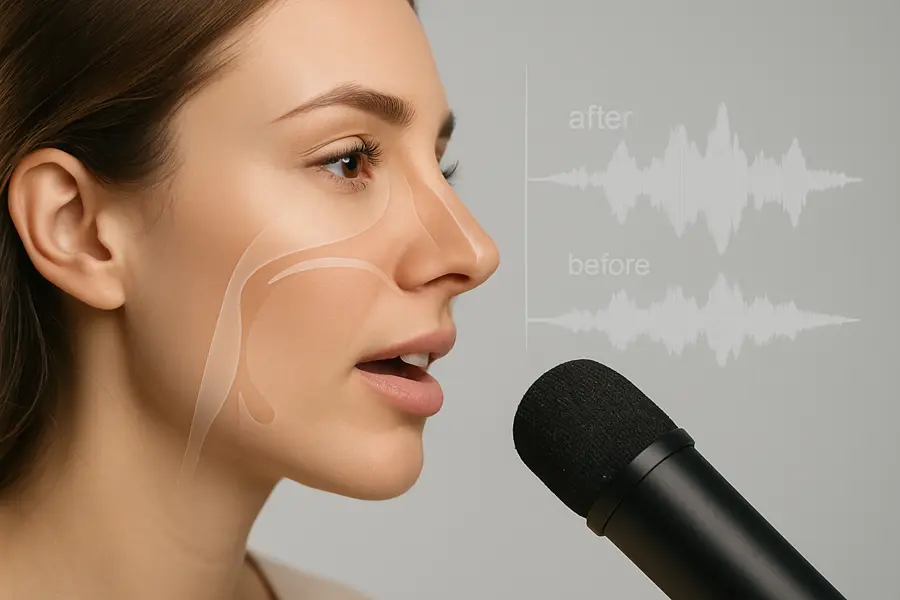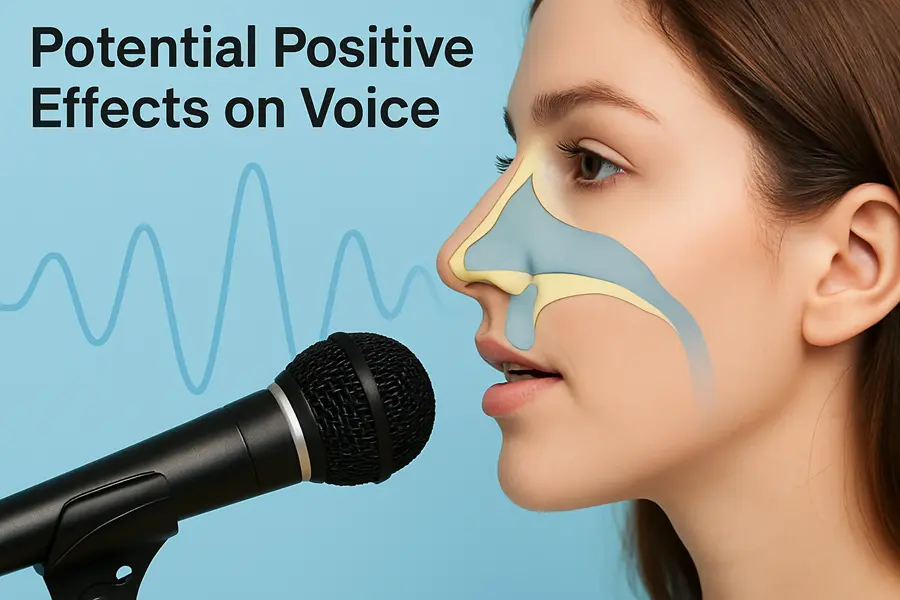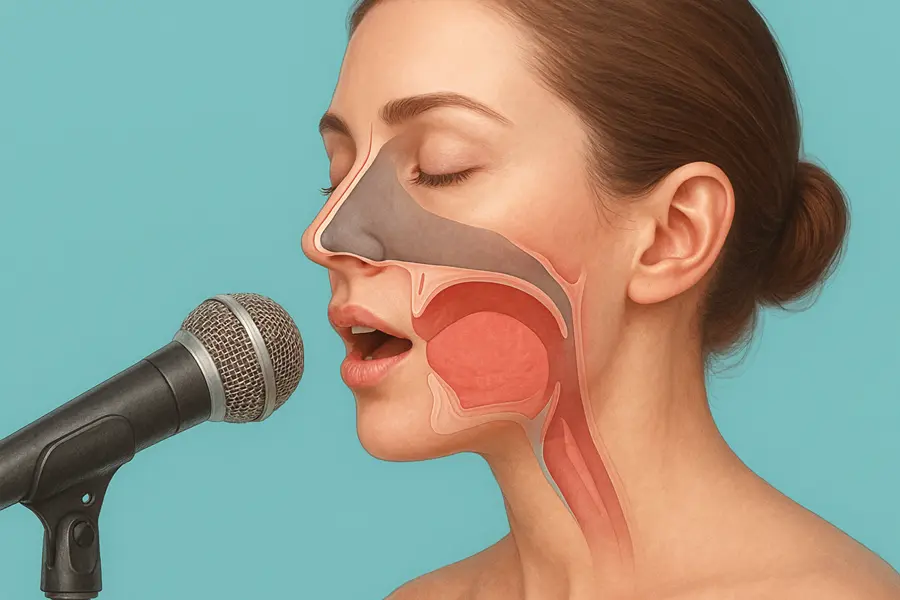Can nose surgery affect your voice? This is a legitimate concern, especially for singers, public speakers, and anyone whose voice is central to their profession.
If you're considering rhinoplasty, you might wonder: can nose surgery affect your voice? This is a legitimate concern, especially for singers, public speakers, and anyone whose voice is central to their profession. Understanding the relationship between nasal structure and vocal quality can help you make an informed decision about rhinoplasty.
Your nose plays a crucial role in voice production through a process called nasal resonance. When you speak or sing, air flows through your nasal passages, creating vibrations that contribute to your voice’s unique tone and quality. The size, shape, and internal structure of your nose directly impact how sound resonates.
The nasal cavity acts as a natural amplifier, particularly for certain sounds like “m,” “n,” and “ng.” Changes to this resonating chamber through rhinoplasty can potentially alter how your voice sounds to others and even to yourself.
Scientific studies on rhinoplasty and voice changes show mixed results. A 2019 study published in the Journal of Voice found that approximately 15-20% of rhinoplasty patients experienced some degree of voice change, though most were subtle and temporary.
Research indicates that structural rhinoplasty (affecting internal nasal passages) is more likely to impact voice than cosmetic changes to the external nose shape. Procedures involving the nasal septum, turbinates, or significant reduction of nasal volume carry higher risks for voice alterations.
Most voice changes occur immediately after surgery due to swelling and typically resolve within 3-6 months as tissues heal and settle into their new configuration.


Contrary to common concerns, rhinoplasty can sometimes improve voice quality, particularly when addressing functional issues:
● Enhanced airflow: Correcting a deviated septum or removing nasal obstructions can improve breathing and reduce nasal congestion that muffles the voice
● Reduced nasality: Some patients with excessive nasal resonance find their speech becomes more balanced post-surgery
● Better projection: Improved nasal breathing can enhance overall vocal support and projection
Professional singers have reported clearer tone and improved breath control following functional rhinoplasty procedures.
However, rhinoplasty can also negatively impact voice quality:
● Hyponasality: Over-correction or excessive tissue removal can create a “blocked nose” sound
● Loss of resonance: Significant changes to nasal cavity size may reduce natural amplification
● Vocal fatigue: Altered airflow patterns might require vocal adjustment, leading to temporary strain
These effects are typically more pronounced when extensive structural changes are made to the internal nose.
Professional vocalists and public speakers should exercise extra caution when considering rhinoplasty. Voice is their livelihood, making even subtle changes potentially career-affecting.
Recommendations for voice professionals include:
● Consulting with both a rhinoplasty surgeon and a voice specialist
● Considering non-surgical alternatives first
● Timing surgery during vocal “off-seasons”
● Planning for extended recovery periods
● Working with a speech-language pathologist post-surgery if needed
Many professional singers opt for conservative approaches, addressing only functional issues while preserving nasal resonance characteristics.

Patient reports vary widely regarding voice changes after rhinoplasty. In online forums and medical surveys, experiences range from:
● No noticeable change (60-70% of patients)
● Subtle improvements in clarity and breathing (20-25%)
● Minor voice alterations that required adjustment (10-15%)
● Significant voice changes requiring speech therapy (less than 5%)
Most patients who experience voice changes report adaptation within several months, though some permanent alterations do occur.
To reduce the likelihood of unwanted voice changes:
1. Choose an experienced surgeon familiar with functional nasal anatomy
2. Discuss voice concerns explicitly during consultation
3. Consider conservative approaches that preserve nasal volume
4. Plan adequate recovery time before important vocal performances
5. Follow post-operative care instructions carefully
6. Consider voice therapy if changes occur
Open communication with your surgeon about voice-related goals and concerns is essential for optimal outcomes.
A: Most temporary changes resolve within 3-6 months as swelling subsides. Permanent changes, while less common, can occur if significant structural alterations are made.
A: Singing voices may be more sensitive to nasal changes than speaking voices. Professional singers should discuss specific concerns with their surgeon and consider consulting a voice specialist.
A: While not entirely preventable, choosing an experienced surgeon, discussing voice concerns, and opting for conservative techniques can minimize risks.
A: Contact your surgeon immediately. Most changes are temporary due to swelling, but persistent alterations may benefit from voice therapy or additional evaluation.
Areas of Expertise

"Rhinoplasty offers an aesthetic and functional appearance by providing facial harmony."
"Rhinoplasty offers an aesthetic and functional appearance by providing facial harmony."
Detailed Info"Sinusitis is a painful condition caused by inflammation of the sinuses around the nose."
"Sinusitis is a painful condition caused by inflammation of the sinuses around the nose."
Detailed Info"Tonsil diseases are conditions that cause infection and swelling in the throat."
"Tonsil diseases are conditions that cause infection and swelling in the throat."
Detailed Info"Adenoids in children are enlarged lymphoid tissue that can cause nasal congestion."
"Adenoids in children are enlarged lymphoid tissue that can cause nasal congestion."
Detailed Info"Botulinum Toxin provides a youthful and smooth appearance on the face by reducing wrinkles."
"Botulinum Toxin provides a youthful and smooth appearance on the face by reducing wrinkles."
Detailed Info"In children, otitis media can cause earache and hearing problems."
"Facial rejuvenation with non-surgical methods reduces wrinkles and revitalizes the skin."
"Facial rejuvenation with non-surgical methods reduces wrinkles and revitalizes the skin."
Detailed Info"Sleep apnea is a disorder that causes breathing pauses during sleep."
At Dr. Osman Halit Çam’s clinic, we offer internationally recognized, patient-centered care with cutting-edge techniques in modern rhinoplasty and facial aesthetics.
From consultation to recovery, our mission is to provide personalized treatment in a safe, comfortable, and world-class medical environment.
Health innovations, treatment processes, and the latest news about our clinic are shared here.
A Comprehensive Guide to Rhinoplasty Correction Nose Job for Crooked Nose Nose job for crooked nose correction, understanding the procedure, benefits, and what to expect can help you make an informed decision about this transformative treatment. Get Info Nose job for crooked nose A crooked nose can significantly impact both your appearance and quality of […]
Your Complete Guide to Rhinoplasty and Piercings Can I Get a Nose Job with Nose Piercing Can I get nose job with nose piercing? This is one of the most common questions patients ask when planning their cosmetic surgery journey. Get Info Can I Get a Nose Job with Nose Piercing? If you’re considering rhinoplasty […]
What Older Adults Need to Know About Nose Surgery Rhinoplasty When You Get Old Rhinoplasty when you get old presents unique considerations that differ significantly from procedures performed on younger patients. Get Info What Older Adults Need to Know About Nose Surgery Rhinoplasty when you get old presents unique considerations that differ significantly from procedures […]
Each of the contents on this site has been prepared for informational purposes. Do not apply any of the treatment methods described on the site without the supervision of a doctor. Otherwise, the site management and Assoc. Prof. will not be responsible in any way for any problems that may arise. Dr. Osman Halit Çam is not responsible.
© 2023 – All Rights Reserved. Assoc. Dr. Osman Halit Cam
Last Updated: 25.07.2025